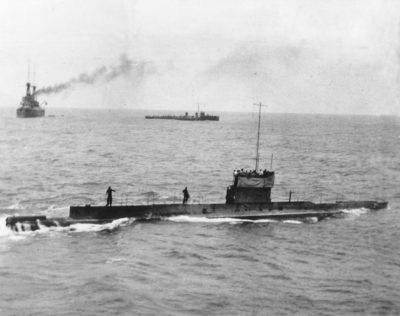
The Naval Historical Society of Australia outlines the role of the RAN in World War I
The newest navy in the world at the beginning of the War, The Royal Australian Navy, had by the end of World War One served at sea, on land and underwater. It served in the Pacific, Indian Ocean, the Mediterranean and the Atlantic with distinction, tragedy and commitment to duty.
The first task of the RAN was to protect Australian ports, shipping and trade routes.
On 1st August 1914, the day war with Germany was announced, a young RAN midshipman signaled Fort Nepean in the Port of Melbourne that a German merchant ship was trying to escape internment.
A shot fired across its bow stopped its escape. The first shot of the war.
The RAN was tasked to disrupt German activities in the Pacific including New Guinea, Nauru and Samoa. The capture of Rabaul by the Australian Naval and Military Force was the first combined sea and land operation for the RAN.
Able Seaman Williams’ death by sniper fire at Rabaul was the first Australian casualty.
The disappearance of AE1 and the presumed loss of 35 men was the first RAN vessel loss and the largest loss of life in a single incident during the whole of WWI for the RAN.
HMAS Australia, Flag ship of the RAN throughout the war, while anxious to pursue the German Pacific Fleet, was ordered back from Samoa to protect Australian waters. The German fleet went on to shell Tahiti before sinking two RN vessels at the Battle of Coronel and finally itself being sunk by the Royal Navy during the Battle of the Falklands.
RAN vessels escorted the first ANZAC forces sent to Egypt in 1915.
HMAS Sydney while on escort duty responded to an emergency call from Cocos Islands and on encountering the German Cruiser SMS Emden engaged the enemy. The battered Emden finally was beached and shelling only stopped when the German ensign was run down.
With the destruction of the German Pacific Fleet and the German raider, RAN vessels if not tasked on troop convoy escort duty were incorporated into the Royal Navy.
Submarine AE2 in April 1915 was the first submarine to breach the Dardanelles and caused havoc in the Sea of Marmara until it was attacked by a Turkish torpedo boat, severely damaged and scuttled.
Its crew were saved but then captured by the Turks. Four crew members died while prisoners of war with remainder released after the Armistice of 1918.
Ist Royal Australian Naval Bridging Train, commanded by Cmdr. Leighton Bracegirdle, undertook multifarious work including building and maintaining wharves on Gallipoli, managing stores and building light rail while operating distilling plants to provide fresh water to the troops. Returned to Egypt, it operated pontoon bridges in the Suez Canal Zone. Elements participated in the unopposed landing at El Arish in the Sinai before the eventual disbandment in 1916. The 1st RANBT was the most decorated unit of the RAN during WW1.
The obsolete HMAS Pioneer was part of the blockade of German East Africa, firing more rounds in action than any other RAN vessel during the war.
3 HMAS Australia, was part of the RN Grand Fleet in the North Sea blockading the German High Seas Fleet. Along with HMAS Melbourne, returned from the West Indies, it spent the remainder of the war in an atmosphere of monotony and frustration at not seeing action.
Eleven RAN volunteers took part in the attack on Zeebrugge and Ostend to sink block ships in the harbours and thus deny the use of the ports to German U Boats.
The Australian Torpedo Boat Destroyer Flotilla blockaded the Adriatic and were part of the forces known as the Otranto barrage. The Australian ships were absorbed into the 5th British Destroyer Flotilla as part of a force which ultimately numbered more than 200 vessels including 35 destroyers and submarines 5075 personnel served in the RAN in 63 vessels (22 STUFT) with the loss of AE1 and AE2.
The personal tragedy of war was for 171 died: 13 killed in action; 13 accidentally killed; 36 missing presumed dead; 86 died of illness; 4 died as prisoners of war and 19 drowned



